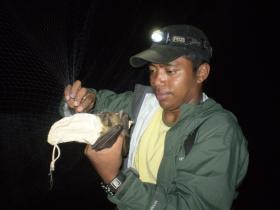By Dr. Aida Cuní Sanchez – TBA alumna, Kirindy 2005

Northern Kenya conjures up images of deserts, nomadic camel pastoralists and, unfortunately, the devastating effects of recurrent droughts. However, there are a few forest islands located on top of high hills and mountains. These forests survive because of the mist they trap from the clouds, which is why they are called cloud forests.
Cloud forests are of particular interest, for their species richness and endemism. For example, three chameleons are endemic to three of these forests in northern Kenya: Trioceros marsabitensis, T. narraioca and Kinyongia asheorum, which inhabit Mt Marsabit, Mt Kulal and Mt Nyiro forests respectively. These cloud forests also provide a habitat for several endangered species of plants and animals, such as the tree Prunus africana, Grevy’s zebra and elephants.

- Filming in the forest of Mt. Kulal
Most importantly, cloud forests are vital because of their high water yield. In the African drylands, this water yield is crucial to surrounding communities, particularly during droughts. In spite of their important role, little is known about how these forests function, and how sensitive they might be to overexploitation and climate change. So, for the past two years, I have made these fascinating ecosystems the focus of my research.
Continue reading “New insights on forests islands in the desert”



